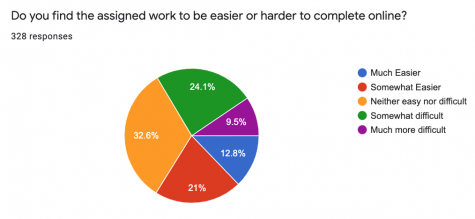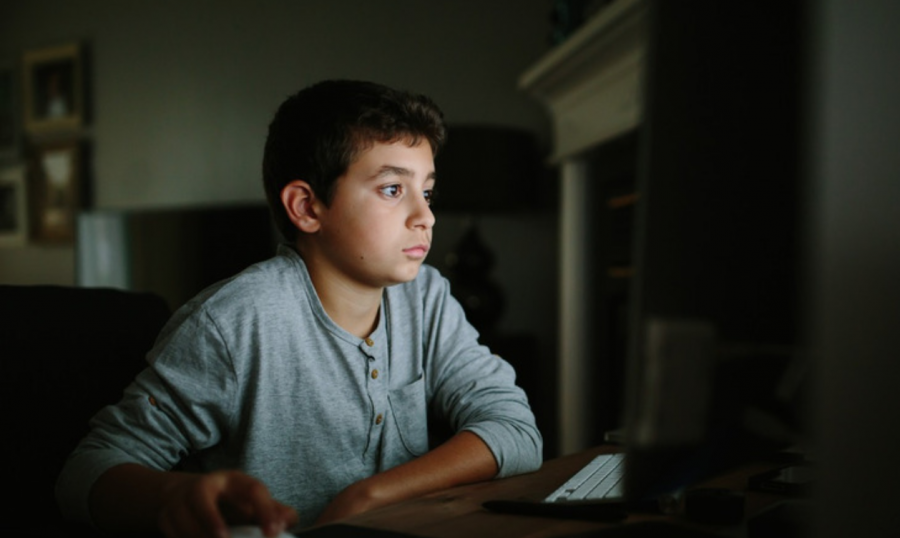Virtual Learning At Canyon High School; The Negative Side Effects and Student Feedback
Student opinion and summaries from education-based and health studies that go over the negative side of the transfer to online schooling.
September 14, 2020
As with the rest of California, students at Canyon High School logged onto their 2020-2021 school year virtually due to Orange County’s widespread transmission of COVID-19. Virtual schooling protects students from possible contact with the coronavirus, however, due to transferring online, students are now being forced into situations that could damage their physical, emotional, and mental health.
For virtual classes at Canyon High School, students are expected to log onto an electronic device to start their day early in the morning. Depending on a student’s schedule, they will have three to four classes each day and will be expected to remain present for the entire duration of a class period. Each class period is one hour and twenty-five minutes long. This means that every day, students will be staring at a screen for up to five hours with two major designated breaks, and a 10-minute grace period between transferring from class to class; a ten-minute nutrition period, one for a half-hour lunch, and only 10 minutes between first-to-second, second-to-lunch, and lunch-to-third period. Teachers have the option to grant additional breaks to students if they so choose.
Staring at a screen for so long can cause quite a few issues. According to the US National Library of Medicine, the blue light from most electronic devices is a melatonin inhibitor, which affects our body’s ability to maintain a healthy sleep cycle. The artificial, backlit screen from electronic devices is known to cause eye-strain in as little as one hour of use. Eye-strain can lead to fatigue, headaches, eye pain, and sensitivity to light. The impacts these two conditions have on students can affect their ability to perform critical analysis, mood, anxiety levels, and basic functioning skills. All of which are tested and stretched during classes.
Another problem is acquiring an electronic device is incredibly difficult for some students. Many may have to share a family computer or tablet with siblings, or can’t afford to rent a laptop for the quarter. School-provided Chromebooks are only a temporary solution, and if one breaks, the school may or may not be able to replace it for the student. For participatory points, teachers encourage students to have their cameras on, and to use their microphone to answer questions rather than typing in chat. They want to encourage students to speak, so they may have the same experience of verbally answering questions as they would be doing in an in-person setting.
This can be harmful to many students because a student’s home life should not be public information to their peers. A student should not have to disclose personal, sometimes emotional, information to a teacher to be allowed to turn their camera off.
Another issue with online schooling is isolation. Unlike in an on-campus setting, where students can see, speak, and interact with one another, online settings prohibit students from having private conversations, and many students prefer to keep their cameras off for personal reasons. This leaves students with a classroom of silent, invisible, and isolated peers. One student commented on the awkward nature of breakout rooms.
“Breakout rooms and group projects are very awkward. Most of the time we’re sitting there with no camera on and only one or two people talk.”
The lack of a social and emotional connection, the formation of in-class friendships, is detrimental to a student’s emotional health. They no longer have an outlet during class to talk with friends, or to find a group of people they’re comfortable working with. Breakout rooms in online settings are randomly picked by the teacher, and some students may have no idea who their peers are. The awkwardness in a breakout room causes many students to turn off both their camera and their microphone, creating a quiet and unproductive room for however long they are expected to collaborate.
There is also a lack of personal understanding between teachers and their students. In an in-person setting, students are present during class and have the opportunity to elect to participate if they so choose. In an online setting, many students find it difficult to participate because they don’t have the cushion of other students also vying for the teacher’s attention when asked to answer a question. Teachers also don’t pick up on student’s quirks if called on. Students with speech impediments are expected to respond through the microphone rather than typing out an answer. Forced participation is never well-received on the student’s end, mainly because when a student does not try to answer a question, there is a reason behind it. According to Brookings Institute, forcing students to participate can lead to social embarrassment, increased anxiety, and a distrust of the teacher. In an in-person class, participation is based on which students want to answer, versus those who make it obvious that they do not. In an online setting, there is no physical indication of if a student is or is not comfortable with answering, which leads to high-anxiety situations when all students don’t know who is next to be called on.
The last pressing issue with online school is the mental strain on a student. Students with learning disabilities, anxiety, underlying health conditions, or who live with a bad family situation in the background already have issues they have to battle with while attending school in person. But online, they are expected to be able to function without in-person accommodations and extra help. According to EdSource, a student research organization, more than half of the 600 students responded that they were in need of mental health services that were now unavailable due to school closure.
Teachers are expected to cover an entire semester’s worth of lesson plans in one quarter. This usually means busywork, nightly and lengthy homework, uninterrupted lectures, and tests and quizzes far more often than what would happen in an on-campus setting. In-person classes take students away from what may be a frustrating home life, and the campus and friends that come with it are a safe haven for them to recuperate and relax. With online school, many students lose that comfort and safety.
Students from Canyon were asked in an anonymous survey what they felt the school should be aware of from the student’s point of view.
“I think teachers think that we now have a ton of time to do school work. Some of them could use a friendly reminder that we have lives and we like our free time,” said one student.
Another wrote, “Honestly, the expectations of work are very high. I understand that there is only so much a teacher can do to make it easier… while at the same time following the regulations set for them. They just need to understand that this workload, although the same amount as when we were in school, is still considerably more difficult, mostly because we do not have the academic push we would have if we were surrounded by peers and teachers.”
When prompted to answer about their confidence in what they will remember from online classes, student responses varied in length, but the message was clear.
“I will most definitely burn out at some point during this year. I understand online classes are necessary for multiple reasons, but it is very hard. I will definitely not gain the same amount of academic education I would be getting if we were back in real school. Many of my classes are hands-on learning, and I myself am a hands-on learner. I will not function at my absolute best without having in time, in class help,” responded one student.
“I’m nervous I won’t be able to keep up with the stress of my classes, I’m already panicking and I’m only taking three at the moment. I feel as if I won’t retain much of the knowledge being thrown at me since the teachers are rushed to teach whole semesters in way less time than usual,” said another.


Student consensus was that even though many understood that the amount of work they were getting was roughly the same amount they would have received in school, the standards and expectations for them are too high to maintain while in an online setting. The stress of dealing with a global pandemic outside of school, the stress of trying to learn virtually, the draining effect that staring at a screen for hours has on the human body, and emotional exhaustion at the end of the school day are all factors to be considered when creating a course for students to follow online.
https://www.ncbi.nlm.nih.gov/pmc/articles/PMC6143346/
https://edsource.org/2020/student-anxiety-depression-increasing-during-school-closures-survey-finds/631224
https://www.edweek.org/ew/articles/2020/03/23/how-effective-is-online-learning-what-the.html
https://www.schoolcounselor-ca.org/Files/Student%20Wellness%20Survey%20Summary%205-08-20.pdf


Steve • May 7, 2021 at 3:13 am
It looks like you’ve misspelled the word “Weeknd” on your website. I thought you would like to know :). Silly mistakes can ruin your site’s credibility. I’ve used a tool called SpellScan.com in the past to keep mistakes off of my website.
-Steve